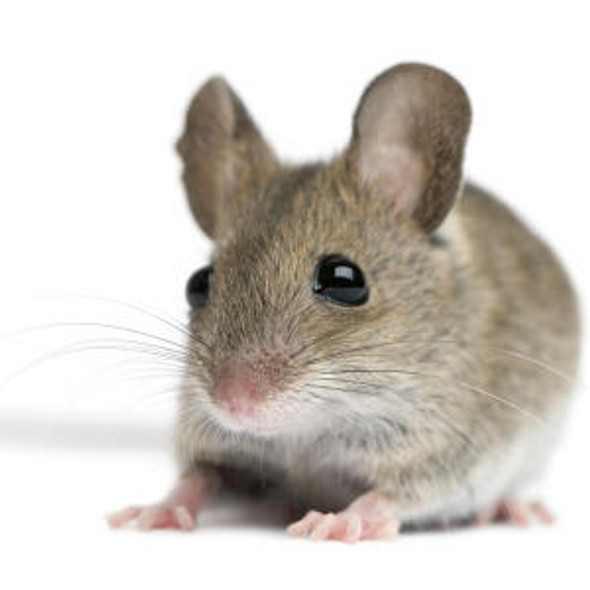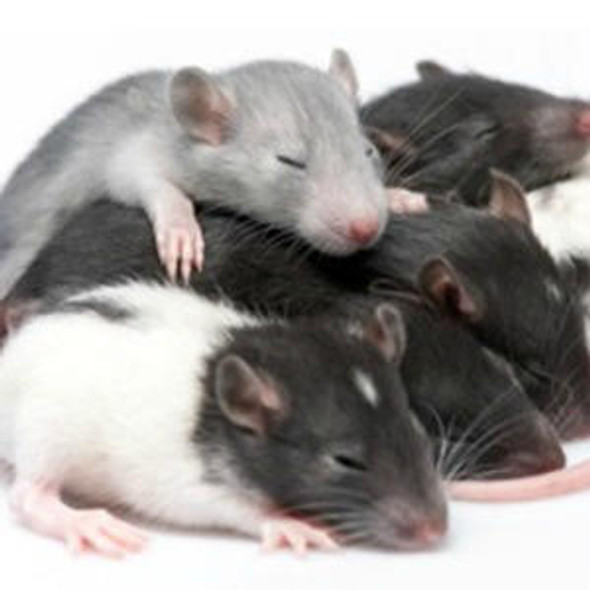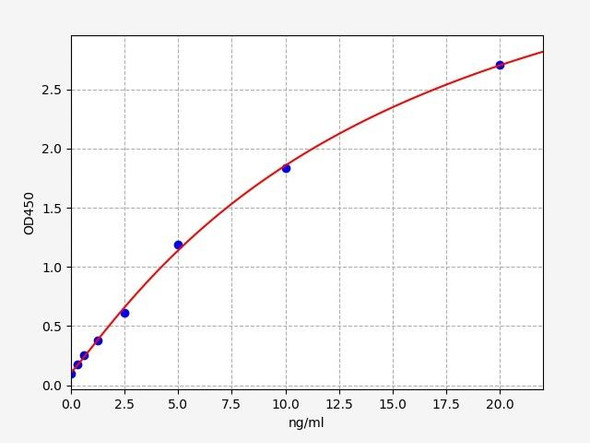Mouse Cd74(HLA class II histocompatibility antigen gamma chain) ELISA Kit
- SKU:
- MOFI01321
- Product Type:
- ELISA Kit
- Size:
- 96 Assays
- Uniprot:
- P04441
- Sensitivity:
- 46.875pg/ml
- Range:
- 78.125-5000pg/ml
- ELISA Type:
- Sandwich ELISA, Double Antibody
- Synonyms:
- CD74, HLA class II histocompatibility antigen gamma chain, CLIP, DHLAG, HLADG, Ii, II, MHC HLA-DR gamma chain, p33, Ia-gamma, INVG34, CD74 antigen, HLA-DR antigens-associated invariant chain, HLA-DR-gamma, Ia antigen-associated invariant chain, Ia-as
- Reactivity:
- Mouse
Description
| Product Name: | Mouse Cd74(HLA class II histocompatibility antigen gamma chain) ELISA Kit |
| Product Code: | MOFI01321 |
| Size: | 96 Assays |
| Alias: | CD74, HLA class II histocompatibility antigen gamma chain, CLIP, DHLAG, HLADG, Ii, II, MHC HLA-DR gamma chain, p33, Ia-gamma, INVG34, CD74 antigen, HLA-DR antigens-associated invariant chain, HLA-DR-gamma, Ia antigen-associated invariant chain, Ia-associated invariant chain |
| Detection Method: | Sandwich ELISA |
| Application: | This immunoassay kit allows for the in vitro quantitative determination of Mouse Cd74 concentrations in serum plasma and other biological fluids. |
| Sensitivity: | 46.875pg/ml |
| Range: | 78.125-5000pg/ml |
| Storage: | 4°C for 6 months |
| Note: | For Research Use Only |
| Recovery: | Matrices listed below were spiked with certain level of Mouse Cd74 and the recovery rates were calculated by comparing the measured value to the expected amount of Mouse Cd74 in samples. Not Available. |
| Linearity: | The linearity of the kit was assayed by testing samples spiked with appropriate concentration of Mouse Cd74 and their serial dilutions. The results were demonstrated by the percentage of calculated concentration to the expected. Not Available. |
| Intra Assay: | CV <8% |
| Inter Assay: | CV <10% |
| Component | Quantity | Storage |
| ELISA Microplate (Dismountable) | 8-12 strips | 4°C for 6 months |
| Lyophilized Standard | 2 | 4°C/-20°C |
| Sample/Standard Dilution Buffer | 20ml | 4°C |
| Biotin-labeled Antibody(Concentrated) | 120ul | 4°C (Protect from light) |
| Antibody Dilution Buffer | 10ml | 4°C |
| HRP-Streptavidin Conjugate(SABC) | 120ul | 4°C (Protect from light) |
| SABC Dilution Buffer | 10ml | 4°C |
| TMB Substrate | 10ml | 4°C (Protect from light) |
| Stop Solution | 10ml | 4°C |
| Wash Buffer(25X) | 30ml | 4°C |
| Plate Sealer | 5 | - |
Other materials and equipment required:
- Microplate reader with 450 nm wavelength filter
- Multichannel Pipette, Pipette, microcentrifuge tubes and disposable pipette tips
- Incubator
- Deionized or distilled water
- Absorbent paper
- Buffer resevoir
| Uniprot | P04441 |
| UniProt Protein Function: | CD74: Plays a critical role in MHC class II antigen processing by stabilizing peptide-free class II alpha/beta heterodimers in a complex soon after their synthesis and directing transport of the complex from the endoplasmic reticulum to the endosomal/lysosomal system where the antigen processing and binding of antigenic peptides to MHC class II takes place. Serves as cell surface receptor for the cytokine MIF. A chromosomal aberration involving CD74 is found in a non-small cell lung tumor. Results in the formation of a CD74- ROS1 chimeric protein. 3 isoforms of the human protein are produced by alternative splicing. Protein type: Membrane protein, integral; Endoplasmic reticulum; Receptor, cytokine Cellular Component: cell surface; endoplasmic reticulum; external side of plasma membrane; Golgi apparatus; integral to membrane; integral to plasma membrane; late endosome; lysosome; membrane; MHC class II protein complex; multivesicular body; plasma membrane; vacuole Molecular Function: beta-amyloid binding; cytokine binding; hematopoietin/interferon-class (D200-domain) cytokine receptor activity; MHC class II protein binding; MHC class II protein binding, via antigen binding groove; nitric-oxide synthase binding; protein binding Biological Process: activation of MAPK activity; adaptive immune response; antigen processing and presentation; antigen processing and presentation of exogenous peptide antigen via MHC class II; cell proliferation; chaperone cofactor-dependent protein folding; defense response; immune response; immune system process; immunoglobulin mediated immune response; intracellular protein transport; negative regulation of apoptosis; negative regulation of DNA damage response, signal transduction by p53 class mediator; negative regulation of mature B cell apoptosis; negative regulation of peptide secretion; negative regulation of T cell differentiation; negative thymic T cell selection; positive regulation of adaptive immune response; positive regulation of B cell proliferation; positive regulation of cytokine and chemokine mediated signaling pathway; positive regulation of dendritic cell antigen processing and presentation; positive regulation of fibroblast proliferation; positive regulation of innate immune response; positive regulation of peptidyl-tyrosine phosphorylation; positive regulation of T cell differentiation; positive regulation of T-helper 2 type immune response; positive thymic T cell selection; prostaglandin biosynthetic process; protein complex assembly; signal transduction |
| UniProt Protein Details: | |
| NCBI Summary: | |
| UniProt Code: | P04441 |
| NCBI GenInfo Identifier: | 110624770 |
| NCBI Gene ID: | 16149 |
| NCBI Accession: | NP_001036070.1 |
| UniProt Secondary Accession: | P04441,O19452 |
| UniProt Related Accession: | P04441 |
| Molecular Weight: | 29.4 kDa |
| NCBI Full Name: | H-2 class II histocompatibility antigen gamma chain isoform 1 |
| NCBI Synonym Full Names: | CD74 antigen (invariant polypeptide of major histocompatibility complex, class II antigen-associated) |
| NCBI Official Symbol: | Cd74 |
| NCBI Official Synonym Symbols: | Ii; CLIP; DHLAG; HLADG; Ia-GAMMA |
| NCBI Protein Information: | H-2 class II histocompatibility antigen gamma chain |
| UniProt Protein Name: | H-2 class II histocompatibility antigen gamma chain |
| UniProt Synonym Protein Names: | Ia antigen-associated invariant chain; Ii; MHC class II-associated invariant chain; CD_antigen: CD74 |
| Protein Family: | H-2 class II histocompatibility antigen |
| UniProt Gene Name: | Cd74 |
| UniProt Entry Name: | HG2A_MOUSE |
*Note: Protocols are specific to each batch/lot. For the correct instructions please follow the protocol included in your kit.
| Step | Procedure |
| 1. | Set standard, test sample and control (zero) wells on the pre-coated plate respectively, and then, record their positions. It is recommended to measure each standard and sample in duplicate. Wash plate 2 times before adding standard, sample and control (zero) wells! |
| 2. | Aliquot 0.1ml standard solutions into the standard wells. |
| 3. | Add 0.1 ml of Sample / Standard dilution buffer into the control (zero) well. |
| 4. | Add 0.1 ml of properly diluted sample (Human serum, plasma, tissue homogenates and other biological fluids.) into test sample wells. |
| 5. | Seal the plate with a cover and incubate at 37 °C for 90 min. |
| 6. | Remove the cover and discard the plate content, clap the plate on the absorbent filter papers or other absorbent material. Do NOT let the wells completely dry at any time. Wash plate X2. |
| 7. | Add 0.1 ml of Biotin- detection antibody working solution into the above wells (standard, test sample & zero wells). Add the solution at the bottom of each well without touching the side wall. |
| 8. | Seal the plate with a cover and incubate at 37°C for 60 min. |
| 9. | Remove the cover, and wash plate 3 times with Wash buffer. Let wash buffer rest in wells for 1 min between each wash. |
| 10. | Add 0.1 ml of SABC working solution into each well, cover the plate and incubate at 37°C for 30 min. |
| 11. | Remove the cover and wash plate 5 times with Wash buffer, and each time let the wash buffer stay in the wells for 1-2 min. |
| 12. | Add 90 µL of TMB substrate into each well, cover the plate and incubate at 37°C in dark within 10-20 min. (Note: This incubation time is for reference use only, the optimal time should be determined by end user.) And the shades of blue can be seen in the first 3-4 wells (with most concentrated standard solutions), the other wells show no obvious color. |
| 13. | Add 50 µL of Stop solution into each well and mix thoroughly. The color changes into yellow immediately. |
| 14. | Read the O.D. absorbance at 450 nm in a microplate reader immediately after adding the stop solution. |
When carrying out an ELISA assay it is important to prepare your samples in order to achieve the best possible results. Below we have a list of procedures for the preparation of samples for different sample types.
| Sample Type | Protocol |
| Serum: | If using serum separator tubes, allow samples to clot for 30 minutes at room temperature. Centrifuge for 10 minutes at 1,000x g. Collect the serum fraction and assay promptly or aliquot and store the samples at -80°C. Avoid multiple freeze-thaw cycles. If serum separator tubes are not being used, allow samples to clot overnight at 2-8°C. Centrifuge for 10 minutes at 1,000x g. Remove serum and assay promptly or aliquot and store the samples at -80°C. Avoid multiple freeze-thaw cycles. |
| Plasma: | Collect plasma using EDTA or heparin as an anticoagulant. Centrifuge samples at 4°C for 15 mins at 1000 - g within 30 mins of collection. Collect the plasma fraction and assay promptly or aliquot and store the samples at -80°C. Avoid multiple freeze-thaw cycles. Note: Over haemolysed samples are not suitable for use with this kit. |
| Urine & Cerebrospinal Fluid: | Collect the urine (mid-stream) in a sterile container, centrifuge for 20 mins at 2000-3000 rpm. Remove supernatant and assay immediately. If any precipitation is detected, repeat the centrifugation step. A similar protocol can be used for cerebrospinal fluid. |
| Cell culture supernatant: | Collect the cell culture media by pipette, followed by centrifugation at 4°C for 20 mins at 1500 rpm. Collect the clear supernatant and assay immediately. |
| Cell lysates: | Solubilize cells in lysis buffer and allow to sit on ice for 30 minutes. Centrifuge tubes at 14,000 x g for 5 minutes to remove insoluble material. Aliquot the supernatant into a new tube and discard the remaining whole cell extract. Quantify total protein concentration using a total protein assay. Assay immediately or aliquot and store at ≤ -20°C. |
| Tissue homogenates: | The preparation of tissue homogenates will vary depending upon tissue type. Rinse tissue with 1X PBS to remove excess blood & homogenize in 20ml of 1X PBS (including protease inhibitors) and store overnight at ≤ -20°C. Two freeze-thaw cycles are required to break the cell membranes. To further disrupt the cell membranes you can sonicate the samples. Centrifuge homogenates for 5 mins at 5000xg. Remove the supernatant and assay immediately or aliquot and store at -20°C or -80°C. |
| Tissue lysates: | Rinse tissue with PBS, cut into 1-2 mm pieces, and homogenize with a tissue homogenizer in PBS. Add an equal volume of RIPA buffer containing protease inhibitors and lyse tissues at room temperature for 30 minutes with gentle agitation. Centrifuge to remove debris. Quantify total protein concentration using a total protein assay. Assay immediately or aliquot and store at ≤ -20 °C. |
| Breast Milk: | Collect milk samples and centrifuge at 10,000 x g for 60 min at 4°C. Aliquot the supernatant and assay. For long term use, store samples at -80°C. Minimize freeze/thaw cycles. |










